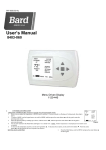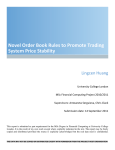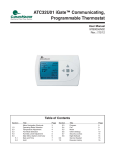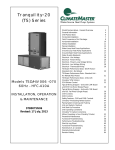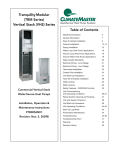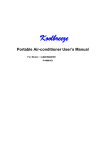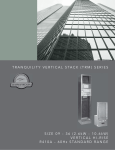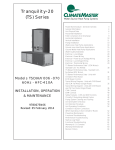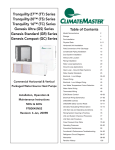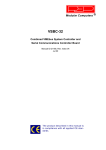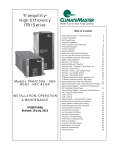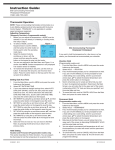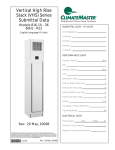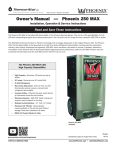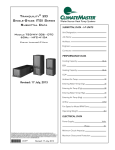Download User`s Manual - Climatemaster
Transcript
997-060180-1 User’s Manual ATP32U01, ATP32U02 Programmable Thermostats ATA32U01 Non-Programmable Thermostats Menu Driven Display 997-060180-1 Heat Pump Thermostat User Information VACATION HOLD (Programmable models only) 1. From the Main Menu, scroll to MENU and press the center button ■ on the keypad. 2. Select HOLD → VACATION 3. First, the thermostat prompts you for a temperature to hold. If you are in AUTO MODE you will be prompted for both a heat setting and a cool setting. Use the up and down arrows keys ▲▼ to select the desired temperature and press the center button on the keypad. 4. Next it will prompt you for a date and time that you wish to return to programmed operation. Returning to the Main Screen, you will notice that in the upper part of the screen is alternating HOLD TIL *date and time you specified* and the actual date and time. 5. To cancel this hold, scroll to CANCEL HOLD from the Main Menu and press the center button ■. PERMANENT HOLD (Programmable models only) 1. From the Main Menu, scroll to MENU and press the center button ■ on the keypad. 2. Select HOLD → PERMANENT 3. First, the thermostat prompts you for a temperature to hold. If you are in AUTO MODE you will be prompted for both a heat setting and a cool setting. Use the up and down arrows keys ▲▼ to select the desired temperature and press the center button on the keypad. 4. Returning to the Main Screen, you will notice that in the upper part of the screen is alternating PERMANENT HOLD and the actual date and time. 5. You can adjust to permanent hold temperature at will, and the temperature you select will remain until the permanent hold is canceled. 6. To cancel this hold, scroll to CANCEL HOLD from the Main Menu and press the center button ■. This will revert to the programmed settings. I. THERMOSTAT OPERATION ADJUSTING TEMPERATURE (Temporary Override in Programmable models) 1. Before you can adjust the temperature, a MODE must be selected. If you are already in a Heating or Cooling mode, then skip to step 5. 2. To select a MODE, use the keypad arrows to scroll to MODE, and then press the center button on the key pad to enter 8/08/05 8:45 AM OUTDOOR FAN AUTO the operating mode menu. 93° HEATING 3. Select the desired mode by scrolling up or down, with the arrows, and then press the AUTO SETPOINT center button on the keypad to enter into that HEAT 62 COOL 85 mode. 4. You are now returned to the Main Menu and RH TEMP MODE FAN MENU Figure 1 is a similar view. NOTE: Outdoor temperature is only displayed if an outdoor sensor Figure1 73° is installed. 5. To increase the temperature set point, use the arrow up button. To decrease the set point, use the arrow down button. Press the center button on the key pad for the new set point to be effective1. SETTING DATE AND TIME 1. From the Main Menu, scroll to MENU and press the center button ■ on the keypad. 2. Select SET DATE AND TIME 3. If your area observes daylight savings time, select AUTO DAYLIGHT SAVING, scroll to ON, then press the center button ■ to save. You will be returned to the select SET DATE AND TIME menu. Scroll to SET DATE AND TIME and press the center button ■ on the keypad. 4. SET MONTH by using the up and down arrows ▲▼, and then press the center button on the keypad to save the month. 5. SET DAY by using the up and down arrows ▲▼, and then press the center button on the keypad to save the day. 6. SET YEAR by using the up and down arrows ▲▼, and then press the center button on the keypad to save the year. 7. SET HOUR by using the up and down arrows ▲▼, and then press the center button on the keypad to save the hour. 8. SET MINUTE by using the up and down arrows ▲▼, and then press the center button ■ on the keypad to save the minute. 9. Date and Time are now set. You can return to the Main Menu by pressing the left arrow key to return to the previous menu. HOLD SETTING -- Vacation & Permanent (Programmable models only) This section describes the HOLD functions. You can program the thermostat to hold the temperature for a period of time. If you want to hold the temperature for a few hours or a few weeks, your thermostat can accommodate your schedule. FAN OPERATION The thermostat can operate the fan in three ways: AUTO (on only during heating and cooling calls) ON (always on) PROGRAMMED FAN (fan follows the program set in the program screen) (programmable models only) 1. From the Main Menu, scroll to MENU and press the center button on the keypad ■. 2. Select FAN. 3. Select the operation you desire as described above. CHANGING MODES OPERATING MODE MENU 1. From the main screen select MODE. OFF 2. Select the operating mode you need and press AUTO the center button ■. COOL NOTE: If selecting EMERGENCY HEAT, HEAT EMERGENCY HEAT the backlight color will change from blue to red indicating that auxiliary heat is operating instead of CHANGE MODE ∇∆ ⊲ PREVIOUS the heat pump compressor. Auxiliary/emergency heat is significantly more expensive to operate than the heat pump compressor, and should not be selected unless the heat pump compressor is not operational. FAHRENHEIT OR CELSIUS 1. From the Main Menu, scroll to MENU and press the center button ■ on the keypad. 2. Select SETINGS → SCREEN SETTINGS → FAHRENHEIT OR CELSIUS 3. Select which scale you prefer. 12 OR 24 HOUR CLOCK Within this menu option, you can change the timed displayed by your thermostat to 24 Hour time (Military Time). 1. From the Main Menu, scroll to MENU and press the center button ■ on the keypad. 2. Select SETINGS → SCREEN SETTINGS → 12 OR 24 HOUR CLOCK 3. Select which time base you prefer. CONTRAST ADJUSTMENT You can change the contrast level of your thermostat screen to be displayed to your preference. 1. From the Main Menu, scroll to MENU and press the center button on the keypad. 2. Select SETINGS → SCREEN SETTINGS →CONTRAST 1 Review PROGRAM and HOLD sections to know effects of changing the set point 2 997-060180-1 3. 4. Use the up and down arrows ▲▼ to increase or decrease the contrast level. Press the center button to accept the new setting. 6. 7. BACKLIGHT ON TIME This thermostat has a two color backlight feature. Anytime a button is pressed, the blue backlight stays on for a certain amount of time. A red backlight is visible if you are selecting Emergency Heat mode. You can adjust the amount of time the backlight stays on in the menu options. 1. From the Main Menu, scroll to MENU and press the center button ■ on the keypad. 2. Select SETINGS → SCREEN SETTINGS →BACKLIGHT ON TIME 3. You can change the backlight on time by using to up and down arrows ▲▼. 30, 60, 90, 120, and ON (all the time) are your choices. Press the center button to save the new backlight on time. II. PROGRAMMING YOUR THERMOSTAT (programmable models only) PROGRAMMING A DAY OR A SERIES OF DAYS After selecting the programming screen, you have the option of programming everyday, weekdays, weekends, or individual days. Once you’ve selected a certain day to program, a screen appears that allows you to set the time, heat setting, cool setting, and fan operation for each event. 1. From the Main Menu, scroll to MENU and press the center button ■ on the keypad. PROGRAM MENU 2. Select PROGRAM SAVE 3. You can program each day differently MONDAY TUESDAY WEDNESDAY by going through each day and THURSDAY FRIDAY personalizing them. Or, you can program SATURDAY SUNDAY EVERY DAY everyday the same by scrolling to WEEKDAYS WEEKENDS EVERYDAY. Or, you can program COPY SELECT OPTION ∇∆ the weekdays or weekends the same by ⊲ PREVIOUS selecting the appropriate menu item. 4. To program everyday the same, select EVERY DAY EVERYDAY and then press the center WAKE HEAT COOL FAN 70 78 AUTO 6:00A button ■. LEAVE 8:00A 62 85 AUTO 5. Using the right arrow button ►, highlight RETURN the WAKE time, and change to desired 5:00P 70 78 AUTO time by using the up and down arrow ▲▼ SLEEP 10:00P 62 82 AUTO buttons. Move to the next entry by using SAVE the right arrow button ►. To change the ⊲ PREVIOUS HEAT set point, use the up and down arrows. Continue this process until all settings are to your liking. 6. To save these setting, scroll to SAVE, and press the center button ■. COPYING A PROGRAM FROM ONE DAY TO ANOTHER In the PROGRAM menu, there is an option to COPY. The option can be used to copy the program from one day to another day. After COPY is selected, the thermostat will prompt you for which day to copy from. Next, it will prompt you for which day to copy the program to. After these selections, it will then confirm what is being copied to where. At this point you have the option of canceling the copy process, by pressing ◄ to return to the copy menu, or saving what you have by pressing the center button ■. The SAVED screen will appear returning you to the copy menu. Pressing ◄ will return you to the PROGRAM menu. Pressing ◄ again will return you to the MAIN MENU. V. ADVANCED SETTINGS SECURITY LOCKOUT This thermostat has the option to set security features to lockout everything but the adjustment of the temperature or a total keypad lockout. 1. From the Main Menu, scroll to MENU and press the center button ■ on the keypad. 2. Select SECURITY LOCKOUT. 3. Select whether you want to lockout everything but TEMP ADJUST ONLY or TOTAL KEYPAD LOCKOUT. 4. Either selection will bring you to the Enter Pin Number screen. 5. Using the up and down arrows ▲▼, select a pin number to lock out the thermostat. The right arrow ► moves you to the next pin digit. SECURITY LOCKOUT TEMP ADJUST ONLY TOTAL KEYPAD LOCKOUT SELECT OPTION ∇∆ ⊲ PREVIOUS SECURITY LOCKOUT ENTER PIN NUMBER 0000 CHANGE NUMBER ∇∆ ⊲ PREVIOUS 8. 9. Once you’ve entered the 4-digit pin number, press the center button ■ to save the pin. The screen will display LOCKED and return to the main Screen. Once you return to the Main Screen, in the upper left of the screen will alternate between LOCKED and the date and time. If you selected TEMP ADJUST ONLY, you will only be able to adjust the set point temperature. Any other operation will require the pin number to unlock the thermostat. Once unlocked, you’ll have to set a pin number again to lockout the thermostat again. OFFSETS 1. MENU → SETTINGS → OFFSETS TEMPERATURE OFFSETS This option allows calibration (or deliberate miscalibration) of the room temperature sensor(s). There are various reasons why the displayed temperature would be adjusted to a higher or lower value. NOTE: Do not adjust for 30 minutes after installation because board may be heated by handling. The selected number is the number of degrees, plus or minus, which will be added to actual temperature. The numbers can range between -5˚ and +5˚. Default values are set to 0˚ offset. Temperature Offset Remote Indoor Offset (if sensor is attached) Outdoor Offset (if sensor is attached) HUMIDITY OFFSET This option allows calibration of the humidity sensor. Adjustments can range between -10% and +10%. Default is 0% offset. ANTICIPATOR This adjustment controls the sensitivity and cycle rate of the thermostat. Higher numbers decrease the cycle rate. Lower numbers increase the cycle rate. Default value is 4, and the range is 0-9. DIFFERENTIAL This adjustment will vary the number of degrees, from the set point, before a call for heating or cooling is made. Adjustments can range between 1˚ and 4˚ differential. Default is 2˚ offset. (If your set point is 70˚F in heating, your thermostat will not call for heat until the temperature is 68˚F, with a 2˚ differential). CYCLES PER HOUR This feature will not allow more than the specified number of equipment cycles per hour. Values can range from 4 or 6 (or 1 cycle every 15 minutes (default) or 1 cycle every 10 minutes, if 6 is set). Factory default setting is 4. This default selection will provide optimum performance in nearly all installations. MENU → SETTINGS → CYCLES PER HOUR AUTO CHANGEOVER With auto changeover, the thermostat automatically switches itself from heating to cooling, or vise versa, based on the setpoints. When setting up the thermostat you have to enter both a cooling setpoint and a heating setpoint. The thermostat will also prevent the user from setting the cooling setpoint lower than the heating setpoint. Mode is set to AUTO for this operation to work. MENU → SETTINGS → AUTO CHANGEOVER Auto Changeover Time - This setting sets the minimum off time before the thermostat can change from one mode to another. Default is 60 minutes. Range is from 0-120 minutes in 15 minute increments. Auto or Manual Change – Default is AUTO. If MANUAL is chosen, you will need to change from heating to cooling or vise versa. When MANUAL is set, AUTO is removed from the MODE screen as a choice. PROGRAM SETTINGS 1. MENU → SETTINGS → PROGRAM SETTINGS SMART RECOVERY Smart recovery is a feature of your thermostat designed to save energy by gradually adjusting temperatures. When it’s time for a programmed 1 Review PROGRAM and HOLD sections to know effects of changing the set point 3 997-060180-1 temperature change, smart recovery begins working in advance, turning the system on and off as needed to slowly adjust the indoor temperature. During these transition periods, you may notice that the actual temperature and your temperature setting don’t match. That’s smart recovery in action, adjusting temperatures in small increments for greater energy efficiency. This is more energy efficient than simply allowing the system to operate at full capacity until the desired temperature has been met. Smart Recovery helps avoid excessive use of auxiliary heat when recovering from night setback in the heating mode. SERVICE INFORMATION These screens help an installer or contractor to have a good understanding of what problems might be occurring before arriving for service. SERVICE INFORMATION FAULT STATUS SAFETY STATUS INPUT STATUS OUTPUT STATUS TEMPERATURE STATUS CLEAR FAULT HISTORY SELECT OPTION ∇∆ ⊲ PREVIOUS EVENTS PER DAY This is where you can set the number of events per EVENTS PER DAY day. (An event is a period of time scheduled with a 4 - RESIDENTIAL certain heating and cooling setpoint.) For instance if 2 – RESIDENTIAL you are away from your home from 8am to 5pm, 2 - BUSINESS make this period of time an event and set the SELECT OPTION ∇∆ thermostat at an energy saving setting. You have the ⊲ PREVIOUS option of setting the events per day to 4RESIDENTIAL (4 events), 2-RESIDENTIAL (2 events) or 2-BUSINESS (2 events). EVERY DAY WAKE HEAT COOL 70 78 6:00A LEAVE 8:00A 62 85 FAN AUTO AUTO RETURN 5:00P 70 78 AUTO SLEEP 10:00P 62 82 AUTO EVERY DAY DAY 6:00A NIGHT 10:00P HEAT COOL 70 78 62 82 EVERY DAY FAN AUTO ACTIVE 6:00A AUTO IDLE 10:00P HEAT COOL FAN 70 78 AUTO 62 SAVE SAVE SAVE ⊲ PREVIOUS ⊲ PREVIOUS ⊲ PREVIOUS 4-RESIDENTIAL (Default) 2-RESIDENTIAL 82 AUTO 2-BUSINESS SMART HEAT STAGING (HEAT PUMP ONLY) This will allow the thermostat to engage in 3rd stage heating if needed. Options are ON or OFF. Default is OFF. Range for this are 0-120 minutes in 5 minute increments, if set to ON. 30 minutes is the default time. This is the time before the electric heat is engaged. COOLING LOCKOUT When an outdoor temperature sensor is installed, you can set it up so cooling option doesn’t energize if the outdoor temperature is below a certain temperature. Ranges for this are NONE (default), 45˚F, 50˚F, or 55˚F. ELECTRIC HEAT LOCKOUT When an outdoor temperature sensor is installed, you can set it up so the electric heat option doesn’t energize if the outdoor temperature is above a certain temperature. Ranges for this are NONE (default), 5˚F to 60˚F in 5˚ increments. INTERMITTENT FAN Temperature conditions can vary widely between the thermostat location and extremities of the space the thermostat serves. This air stratification problem can be especially pronounced during mild outdoor conditions when long periods elapse between space conditioning demands from the thermostat. This intermittent fan operation can also improve the performance of air cleaning or special filtration systems that locate the cleaning or filtration media at the return air side of the fan. 1. 2. 3. 4. 5. MENU → SETTINGS → INTERMITTENT INTERMITTENT FAN NO HEAT OR COOL CALL FAN FAN ON TIME If the FAN hasn’t been on for an hour, the fan will start cycling based on these times. Default is MINUTES OFF. The first screen is the amount of time you CHANGE SETTING ∇∆ want the fan to be energized. Ranges are OFF, or ⊲ PREVIOUS 5-20 minutes in 5 minute increments. After entering this time and pressing the center button ■, the next screen is the amount of time the fan is OFF. Ranges are INTERMITTENT FAN 0 minutes, or 5-40 minutes in 5 minute NO HEAT OR COOL CALL FAN OFF TIME increments. After entering this time and pressing the center button ■ you will be returned to the Setting Menu MINUTES screen. CHANGE SETTING ∇∆ ⊲ PREVIOUS Fan ON and OFF cycles will continue until the fan has been energized by a call for heating or cooling. 5 10 1 Review PROGRAM and HOLD sections to know effects of changing the set point 4 997-060180-1 INSTALLER INFORMATION / ADVANCED FEATURES SAFETY CONSIDERATIONS Improper wiring or installation may damage thermostat. Wiring must conform to local and national electrical codes WARNING: Before installing thermostat, turn off all power to unit. There may be more than one power disconnect. Electrical shock can cause personal injury or death. INTRODUCTION The thermostat is a wall mounted, low-voltage thermostat which maintains room temperature by controlling the operation of a heating and air conditioning system. Batteries are not required; temperature and mode settings are preserved with the power off. INSTALLATION CONSIDERATIONS The thermostat requires no batteries. The thermostat is not a power stealing device and MUST have both R and C connected. INSTALLATION III. THERMOSTAT LOCATION Thermostat should be mounted: - Approximately 5 ft. (1.5m) from floor. - Close to or in a frequently used room, preferably on an inside partitioning wall. - On a section of wall without pipes or duct work. Thermostat should NOT be mounted: - Close to a window, on an outside wall, or next to a door leading to the outside. - Exposed to direct light and heat from a lamp, sun, fireplace, or other temperature-radiating object which may cause a false reading. - Close to or in direct airflow from supply registers and return-air grilles. - In areas with poor air circulation, such as behind a door or in an alcove. IV. INSTALL THERMOSTAT 1. Turn off all power to unit. 2. If an existing thermostat is being replaced: A. Remove existing thermostat from wall. B. Disconnect wires from existing thermostat, one at a time. Be careful not to allow wires to fall back into the wall. C. As each wire is disconnected, record wire color and terminal marking. D. Discard or recycle old thermostat. NOTE: Mercury is a hazardous waste and MUST be disposed of properly. 3. Separate the front and back pieces of plastic. 4. Route thermostat wires through hole in back piece of plastic. Level plastic against wall (for aesthetic value only - thermostat need not be leveled for proper operation) and mark wall through 2 mounting holes. 5. Drill two 3/16-in. mounting holes in wall where marked. (Note: Mounting holes on thermostat are designed to fit on a horizontal J-box). 6. Secure back plastic to wall with 2 anchors and screws provided making sure all wires extend through hole in plastic. 7. Connect wires to proper terminal of the connector block in the front plastic. 8. Push any excess wire back into wall. Excess wire inside the thermostat plastic case can interfere with proper air flow across the temperature sensor. Seal hole in wall to prevent air leaks. Leaks can affect operation. 9. Snap front and back pieces of plastic together. 10. Turn on power to the unit. WIRING DIAGRAMS All excess wire should be pushed back into the wall as far as possible. Excess wire inside the thermostat plastic case may interfere with the air flow across the temperature sensor. NOTES: 1. Single compressor units with CXM control only (No ECM fan) do not use terminal Y2. 2. Thermostat terminal W1 only used for backup electric heat. For residential units, thermostat terminal is wired to CXM, DXM or ECM board. For commercial units, thermostat terminal W1 is wired to an external duct heater. 3. For units with ClimaDry modulating reheat, thermostat terminal DH is wired directly to DXM terminal H. 4. For units with ECM fan, thermostat terminal DH is wired to terminal DH on the ECM board. 5. For units with ClimaDry and ECM fan, thermostat terminal DH is wired directly to DXM terminal H (not to the ECM board). THERMOSTAT CONNECTIONS C – 24V Common for Control Circuit DH – Dehumidify Output (ATP32U02 only) R – 24V Supply for Control Circuit W1 – Auxiliary Heat H – Humidifier (ATP32U02 only) O – Reversing Valve - energized in COOL mode Y2 – 2nd Stage Compressor / Cooling / Heating Y1 – 1st Stage Compressor / Cooling / Heating G – Fan L – Alarm Input V – Not Used A+, B – Not Used. GND – Ground OD – Outdoor Temperature Sensor ID – Indoor Temperature Sensor VI. INSTALLER SETTINGS NOTE: These options are intended to be used by the installer. End users are not advised to change or modify any of these settings. Doing so may make your equipment stop working properly and/or may void the warranty of the thermostat as well as the equipment hooked up to the thermostat. To access the installer setting menu, the mode must be set to OFF. Then, press both the up and down arrows keys at the same time for at least 5 seconds to enter the installer screen. MODEL CONFIGURATION Options to select from: HEAT / COOL, Single Stage or Multi Stage or HEAT PUMP, Single Stage or Multi Stage, Electric or Multi Fuel. ACCESSORIES 1 Review PROGRAM and HOLD sections to know effects of changing the set point 5 997-060180-1 Each of these options has settings for Cumulative Run Time and Calendar Time. Messages will flash at the top of the Main screen when these events are met to alert the owner that it is time service these options. Air Filter - Cumulative Run Time default is 1000 hours and Calendar Time is 6 months. Values can range from 400-3600 hours for Cumulative Run Time (in 100 hour increments), or Calendar Time can be set to OFF, or 3-48 months (in 3 month increments). Humidifier - Cumulative Run Time default is 0 hours (OFF) and Calendar Time is OFF. Values can range from 400-3600 hours for Cumulative Run Time (in 100 hour increments), or Calendar Time can be set to OFF, or 3-24 months (in 3 month increments). UV Lamp - Cumulative Run Time default is 0 hours (OFF) and Calendar Time is OFF. Values can range from 400-3600 hours for Cumulative Run Time (in 100 hour increments), or Calendar Time can be set to OFF, or 3-48 months (in 3 month increments). Air Cleaner - Cumulative Run Time default is 0 hours (OFF) and Calendar Time is OFF. Values can range from 400-3600 hours for Cumulative Run Time (in 100 hour increments), or Calendar Time can be set to OFF, or 3-24 months (in 3 month increments). INPUT DEALER INFO Contractors are able to input Brand Name, Model Number, Contractor Name, and Contractor Phone number into these screens. This way, the owner could give this information to the contractor so that he would know what system the owner has prior to the service visit. 1. 2. 3. 4. INPUT DEALER INFO DEALER INFO BRAND NAME MODEL NUMBER CONTRACTOR NAME CONTRACTOR PHONE SAVE BRAND NAME USE ∇∆ TO SCROLL THRU CHARACTERS SELECT OPTION ∇∆ ⊲ PREVIOUS CHANGE LETTER ∇∆ ⊲ PREVIOUS ECM - Operates only when there is a cooling call. This logic will allow thermostat to operate with ECM motor and no ClimaDry option. The ECM control board works on reverse logic. Reverse logic implies that when the humidity is greater than the set point, thermostat energizes the DH output with 0 VAC. ECM fan will run at a slower speed when the DH terminal at the ECM board is energized with 0VAC. When humidity is below setpoint, the 24 VAC output to the ECM board will return the airflow to normal speed. The ECM interprets the 0VAC call, which is actually 13.3VAC at the DH terminal on the ECM control board. BOTH – Same as the ClimaDry logic. NONE – The DH output is not active. REVERSING VALVE OPTION Option of the reversing valve (O output) being on when in cooling or heating. Default is COOLING. RESTORE DEFAULTS This will allow you to revert to the factory default settings. A A _____________________________ Scroll to the info you want to enter and press the center button ■. Enter the information by scroll through the characters using the up & down arrows ▲▼. Once the character you want is set, press the right arrow ► to move to the next space and begin entering another character. Once you’ve completed filling out the field, press the center button ■ to save the entry and return to the INPUT DEALER INFO screen. Repeat this process for all fields you want saved. Once all fields have been entered, scroll to SAVE and press the center button ■. FAN WITH HEAT OPTION Options are ON or OFF. This selection determines whether G (fan) output is to be ON or OFF when W (auxiliary heat) output is ON. ClimateMaster auxiliary heaters require a separate G signal from the thermostat to turn on the blower. In this case, select ON. HUMIDITY OPTION If your system is setup with a humidifier, or a dehumidification option (ClimaDry or ECM dehumidification mode), select the appropriate setting. CLIMADRY ECM BOTH NONE HUMIDITY SETTINGS HUMIDIFY ONLY DEHUMIDIFY ONLY BOTH NONE SELECT OPTION ∇∆ ⊲ PREVIOUS To adjust the Set Point for Humidification or Dehumidification, Select the RH from the Main menu. The values can be selected and adjusted from that screen. NOTE: If you have an outdoor sensor attached to the thermostat, the Humidification setting is adjusted automatically based on the outdoor temperature. CLIMADRY - Operates independent of a cooling call. This logic will allow thermostat to operate with DXM using the ClimaDry option. Standard logic per the DIPs on the DXM implies that when the humidity is greater than the set point, thermostat energizes the DH output with 24 VAC (acts as a dehumidistat). DH output will be 0VAC when humidity is below setpoint. Reverse logic per the DIPs on the DXM implies that when the humidity is greater than the set point, thermostat energizes the DH output with 0 VAC (acts as a humidistat). DH output will be 24VAC when humidity is below setpoint. 1 Review PROGRAM and HOLD sections to know effects of changing the set point 6






